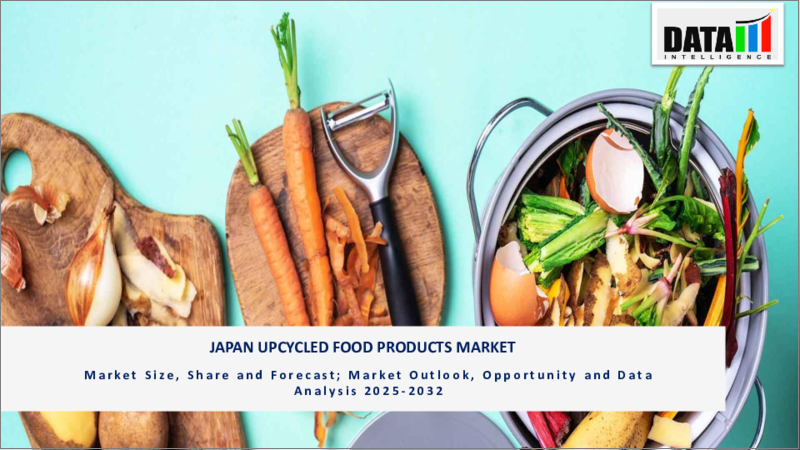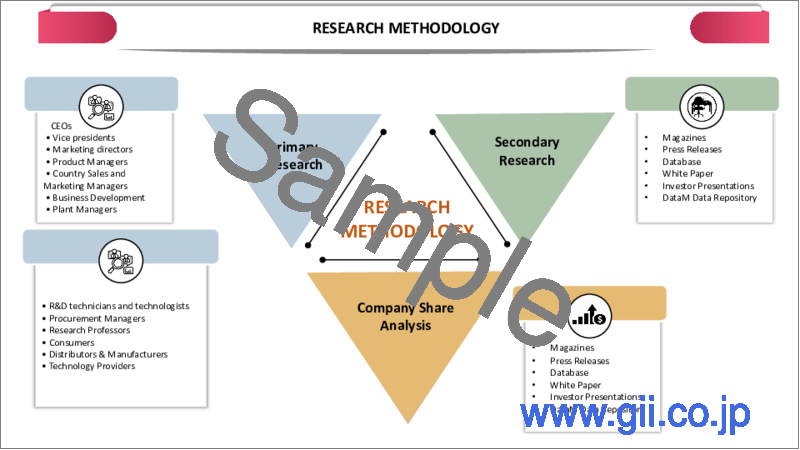|
|
市場調査レポート
商品コード
1629851
日本のアップサイクル食品市場(2024年~2031年)Japan Upcycled Food Products Market - 2024-2031 |
||||||
カスタマイズ可能
適宜更新あり
|
|||||||
| 日本のアップサイクル食品市場(2024年~2031年) |
|
出版日: 2024年12月30日
発行: DataM Intelligence
ページ情報: 英文 195 Pages
納期: 即日から翌営業日
|
- 全表示
- 概要
- 目次
日本のアップサイクル食品市場は2023年に21億米ドルに達し、2031年には38億米ドルに達すると予測され、予測期間2024年~2031年のCAGRは3.4%で成長する見込みです。
日本のアップサイクル食品市場は、消費者の環境意識が高まり、持続可能な代替品を求めるようになるにつれて勢いを増しています。食品廃棄物およびその環境への影響に対する日本の意識の高まりは、本来なら廃棄されるはずの食材を高品質の食品に再利用するアップサイクリングの動向とよく合致しています。同国が野心的な食品廃棄物削減目標の達成に向けて努力していることから、同市場は成長の態勢を整えています。
日本の農林水産省は、2030年度の食品廃棄物削減目標を489万トンと定め、2000年度の980万トンから大幅に減少させました。この目標には、事業所からの273万トン、家庭からの216万トンが含まれます。この取り組みは、国連の持続可能な開発目標(SDGs)の下での、より広範な世界的コミットメントに沿ったものです。SDGsは、2030年までに小売店および消費者レベルでの一人当たり世界食品廃棄量を半減することを求めています。
日本がこのような目標に向けて努力する中、通常なら廃棄される食品を利用するアップサイクル食品は、消費者に革新的で持続可能な代替手段を提供すると同時に、食品廃棄と闘うための重要な解決策となりつつあります。こうした動向の高まりは、環境保全と資源効率に貢献する持続可能な製品に対する認識と需要の高まりを反映しています。
ダイナミクス
政府の取り組みと政策
持続可能性と食品廃棄物削減を目指す政府の取り組みと政策が、この国の市場を牽引しています。政府は持続可能性をますます優先するようになっており、食品廃棄物のリサイクルを促進するための規制、インセンティブ、意識向上キャンペーンを導入しようとしています。こうした政策は、食品廃棄物をスナック、プロテインパウダー、飼料などの価値ある製品にアップサイクルする企業にとって有利な環境を作り出します。これによって環境への影響が削減され、新たな経済機会が開かれるため、アップサイクル食品市場の成長が促進されます。
日本では、政府が2022年に51万トンの食品廃棄物削減を達成し、食品廃棄物削減目標を予定より8年前倒しで達成したことが、アップサイクル食品市場に大きな影響を与えました。日本の持続可能性へのコミットメントは、SDGs指数で第21位、世界経済フォーラムの旅行・観光開発指数で第1位にランクされていることによってさらに実証されており、アップサイクルに焦点を当てた経済成長の重要な推進力として持続可能性を強調しています。
消費者意識の欠如
消費者の意識は、日本におけるアップサイクル食品市場の大きな阻害要因です。日本の消費者の多くは、アップサイクルとは何か、アップサイクルが環境にもたらすメリットについて理解していません。余剰食材をどのように安全に再利用できるかの知識がなければ、こうした製品を採用することにためらいがあります。アップサイクルの概念は馴染みが薄いため、消費者がアップサイクルを望ましい、あるいは信頼できる選択肢として捉えるのは難しいのかもしれません。
日本の消費者は食品の鮮度と品質を強く好みます。伝統的な料理は季節の食材を重視するため、通常なら廃棄されてしまうような食材を使用する可能性のあるアップサイクル製品は、こうした文化的規範にそぐわない可能性があり、鮮度に対するこの文化的偏見を克服することは、日本市場における市場成長の大きな障壁となる可能性があります。
目次
第1章 調査手法と調査範囲
第2章 定義と概要
第3章 エグゼクティブサマリー
第4章 市場力学
- 影響要因
- 促進要因
- 政府の取り組みと政策
- 抑制要因
- 消費者の認識不足
- 機会
- 影響分析
- 促進要因
第5章 産業分析
- ポーターのファイブフォース分析
- サプライチェーン分析
- 価格分析
- 規制分析
- DMIの見解
第6章 供給源別
- 食品廃棄物
- 農業副産物
- 醸造所および蒸留所の廃棄物
- その他
第7章 成分タイプ別
- タンパク質
- 繊維
- 油脂
- 小麦粉
- 甘味料
- その他
第8章 製品別
- スナックと飲み物
- ベーカリーと菓子類
- 原材料と添加物
- 肉・シーフード
- ペットフード
- その他
第9章 流通チャネル別
- スーパーマーケット/ハイパーマーケット
- 専門店
- オンライン
- その他
第10章 競合情勢
- 競合シナリオ
- 市況・シェア分析
- M&A分析
第11章 企業プロファイル
- CRUST Group
- 会社概要
- ネイチャーポートフォリオと説明
- 財務概要
- 主な発展
- Oisix Ra Daichi Co., Ltd.
- Aranea LLC.
- DEAN & DELUCA
- Norwegian Mycelium
- Loss Zero
- Tokyo Co., Ltd.
第12章 付録
Japan's Upcycled Food Products Market reached US$ 2.1 billion in 2023 and is expected to reach US$ 3.8 billion by 2031, growing with a CAGR of 3.4 % during the forecast period 2024-2031.
Japan's upcycled food products market is gaining momentum as consumers become more environmentally conscious and seek sustainable alternatives. The country's growing awareness of food waste and its environmental impact aligns well with the upcycling trend, where ingredients that would otherwise be discarded are repurposed into high-quality food products. The market is poised for growth as the country strives to meet its ambitious food waste reduction goals.
The Ministry of Agriculture, Forestry, and Fisheries of Japan has set a target for fiscal 2030 to reduce food waste to 4.89 million tons, a significant decrease from the 9.8 million tons recorded in fiscal 2000. This target includes 2.73 million tons from businesses and 2.16 million tons from households. The efforts align with the broader global commitment under the United Nations Sustainable Development Goals (SDGs), which call for halving per capita global food waste at the retail and consumer levels by 2030.
As Japan works towards such objectives, upcycled food products, which utilize food that would otherwise be discarded, are becoming a key solution to combat food waste while offering innovative and sustainable alternatives for consumers. This growing trend reflects increasing awareness and demand for sustainable products that contribute to environmental conservation and resource efficiency.
Dynamics
Government Initiatives and Policies
The government initiatives and policies aimed at sustainability and food waste reduction drive the country's market. As governments increasingly prioritize sustainability, they are trying to introduce regulations, incentives, and awareness campaigns to promote the recycling of food waste. These policies create a favorable environment for businesses to upcycle food waste into valuable products like snacks, protein powders, and animal feed. This reduces environmental impact and unlocks new economic opportunities, driving the growth of the upcycled food market.
In Japan, the government's success in reducing food waste achieving a 510,000-ton reduction in 2022 and meeting its food waste reduction target eight years ahead of schedule has significantly impacted the upcycled food market. Japan's commitment to sustainability is further evidenced by its ranking 21st in the SDGs Index and first in the World Economic Forum's Travel & Tourism Development Index, emphasizing sustainability as a key driver of economic growth focussing on upcycling.
Lack of Consumer Awareness
Consumer awareness is a significant restraint for the upcycled food products market in Japan. Many consumers in this country lack an understanding of what upcycling is and the environmental benefits it offers. Without knowledge of how surplus ingredients can be safely repurposed, there is a hesitation to adopt these products. The concept of upcycling may be unfamiliar, making it difficult for consumers to view it as a desirable or trustworthy option.
Japanese consumers have a strong preference for freshness and quality in food. Traditional cuisine emphasizes seasonal ingredients, and upcycled products, which may involve using food that would otherwise be discarded, might not align with these cultural norms. Overcoming this cultural bias toward freshness could be a significant barrier to market growth in the Japanese market.
Segment Analysis
The Japan upcycled food products market is segmented based on source, ingredient type, product, distribution channel, application and region.
Increasing Demand for Healthy Snacks
The Japan upcycled food products market is segmented based on application into snacks & beverages, bakery & confectionery, ingredients & additives, meat & seafood, pet food, and others. The snacks and beverages segment is a dominant force in the upcycled food market, driven by a growing consumer preference for sustainable and health-conscious products. Many innovative snack options are made from surplus or leftover ingredients, such as potato peels turned into chips or fruit-based beverages.
The snacks help reduce food waste but also cater to the increasing demand for healthier, eco-friendly snacks. With a strong cultural emphasis on sustainability and food innovation, Japan is capitalizing on the opportunity to create unique, nutritious snacks that appeal to environmentally-conscious and health-driven consumers. The importance of snacks in Japan's food culture further fuels the success of upcycled products.
According to NZTE, 23% of Japanese consumers eat a snack daily, and healthy snacks currently make up 11% of the total snack market-projected to grow to 13% by 2027. This shift aligns with the rise of upcycled snacks, such as granola made from surplus grains or fruits, which offer both sustainability and nutritional benefits. These products not only reduce food waste but also meet the growing demand for functional, guilt-free snacks, positioning upcycled foods as a key player in Japan's rapidly evolving food market.
Competitive Landscape
The major Japanese players in the market include AIO, Bake Me Healthy, Barnana, cascarafoods, Green Bowl Foods, CRUST Group, I Am Grounded, Matriark Foods, Oisix Ra Daichi Co., Ltd., and Pluck Tea.
Sustainability Analysis
The upcycled food products market in Japan demonstrates a significant commitment to sustainability, addressing both food waste and resource efficiency. As one of the world's most environmentally conscious nations, Japan is increasingly embracing the concept of upcycling, where food by-products or surplus ingredients are transformed into value-added products. This trend reduces the environmental impact of food production by diverting waste from landfills, thus contributing to the country's carbon reduction goals.
Furthermore, it aligns with Japan's growing movement towards circular economies, where materials are reused and recycled, fostering a more sustainable food system. The upcycled food products in Japan are becoming a key component of sustainable consumer behavior. Japanese consumers, known for their discerning tastes and environmental awareness, are increasingly seeking products that not only minimize waste but also offer health benefits.
By Source
- Food Waste
- Agricultural by Products
- Brewery and Distillery Waste
- Other
By Ingredient Type
- Proteins
- Fibers
- Oils and Fats
- Flours
- Sweeteners
- Others
By Product
- Snacks & Beverages
- Bakery & Confectionery
- Ingredients & Additives
- Meat & Seafood
- Pet Food
- Other
By Distribution Channel
- Supermarkets & Hypermarkets
- Specialty Stores
- Online
- Other
Key Developments
- In November 2024, Norwegian Mycelium (NoMy) launched a subsidiary in Sapporo, Japan, to expand its sustainable fermentation technology, upcycling agricultural byproducts into alternative proteins.
- In February 2023, The Nagano Upcycle Food project launched Shinto Goen Ale, an upcycled beer made from food scraps, following its earlier canned food products made from Shinshu Fukumi chicken.
- In August 2024, Upcycled Foods, Inc. unveiled Atoria's Family Bakery Mini Upcycled Naan, a collaboration with the Upcycled Foods Lab. These mini flatbreads are made from upcycled barley, wheat, and rye flour.
Why Purchase the Report?
- To visualize the Japan upcycled food products market segmentation based on source, ingredient type, product, distribution channel, application, and region, as well as understand key commercial assets and players.
- Identify commercial opportunities by analyzing trends and co-development.
- Excel data sheet with numerous upcycled food products market-level data points with all segments.
- PDF report consists of a comprehensive analysis after exhaustive qualitative interviews and an in-depth study.
- Product mapping available as excel consisting of key products of all the major players.
The Japan upcycled food products market report would provide approximately 33 tables, 36 figures and 195 pages.
Target Audience 2024
- Manufacturers/ Buyers
- Industry Investors/Investment Bankers
- Research Professionals
- Emerging Companies
Table of Contents
1. Methodology and Scope
- 1.1. Research Methodology
- 1.2. Research Objective and Scope of the Report
2. Definition and Overview
3. Executive Summary
- 3.1. Snippet by Source
- 3.2. Snippet by Ingredient Type
- 3.3. Snippet by Product
- 3.4. Snippet by Distribution Channel
4. Dynamics
- 4.1. Impacting Factors
- 4.1.1. Drivers
- 4.1.1.1. Government Initiatives and Policies
- 4.1.2. Restraints
- 4.1.2.1. Lack of Consumer Awareness
- 4.1.3. Opportunity
- 4.1.4. Impact Analysis
- 4.1.1. Drivers
5. Industry Analysis
- 5.1. Porter's Five Force Analysis
- 5.2. Supply Chain Analysis
- 5.3. Pricing Analysis
- 5.4. Regulatory Analysis
- 5.5. DMI Opinion
6. By Source
- 6.1. Introduction
- 6.1.1. Market Size Analysis and Y-o-Y Growth Analysis (%), By Source
- 6.1.2. Market Attractiveness Index, By Source
- 6.2. Food Waste
- 6.2.1. Introduction
- 6.2.2. Market Size Analysis and Y-o-Y Growth Analysis (%)
- 6.3. Agricultural by Products
- 6.4. Brewery and Distillery Waste
- 6.5. Other
7. By Ingredient Type
- 7.1. Introduction
- 7.1.1. Market Size Analysis and Y-o-Y Growth Analysis (%), By Ingredient Type
- 7.1.2. Market Attractiveness Index, By Ingredient Type
- 7.2. Proteins
- 7.2.1. Introduction
- 7.2.2. Market Size Analysis and Y-o-Y Growth Analysis (%)
- 7.3. Fibers
- 7.4. Oils and Fats
- 7.5. Flours
- 7.6. Sweeteners
- 7.7. Others
8. By Product
- 8.1. Introduction
- 8.1.1. Market Size Analysis and Y-o-Y Growth Analysis (%), By Product
- 8.1.2. Market Attractiveness Index, By Product
- 8.2. Snacks & Beverages
- 8.2.1. Introduction
- 8.2.2. Market Size Analysis and Y-o-Y Growth Analysis (%)
- 8.3. Bakery & Confectionery
- 8.4. Ingredients & Additives
- 8.5. Meat & Seafood
- 8.6. Pet Food
- 8.7. Other
9. By Distribution Channel
- 9.1. Introduction
- 9.2. Market Size Analysis and Y-o-Y Growth Analysis (%), By Distribution Channel
- 9.3. Market Attractiveness Index, By Distribution Channel
- 9.4. Supermarkets/Hypermarkets
- 9.4.1. Introduction
- 9.4.2. Market Size Analysis and Y-o-Y Growth Analysis (%)
- 9.5. Specialty Stores
- 9.6. Online
- 9.7. Other
10. Competitive Landscape
- 10.1. Competitive Scenario
- 10.2. Market Positioning/Share Analysis
- 10.3. Mergers and Acquisitions Analysis
11. Company Profiles
- 11.1. CRUST Group
- 11.1.1. Company Overview
- 11.1.2. Nature Portfolio and Description
- 11.1.3. Financial Overview
- 11.1.4. Key Developments
- 11.2. Oisix Ra Daichi Co., Ltd.
- 11.3. Aranea LLC.
- 11.4. DEAN & DELUCA
- 11.5. Norwegian Mycelium
- 11.6. Loss Zero
- 11.7. Tokyo Co., Ltd.
LIST NOT EXHAUSTIVE
12. Appendix
- 12.1. About Us and Services
- 12.2. Contact Us






